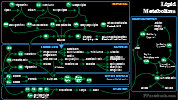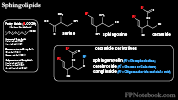II. Definitions
-
Lipid
- Organic molecules containing Hydrocarbons
- Poorly soluble in water, but soluble in organic solvents
- Examples include free Fatty Acids, Triglycerides, phospholipids
- Fatty Acids
- Aliphatic hydrocarbon chain with a terminal COOH group
- Chains vary in length of 6 to 30 carbons (even numbers, sythesized and broken down in 2 carbon increments)
- Major component of fats, with Triglycerides composed of 3 Fatty Acid chains linked to a gylcerol molecule
- Fatty Acids may be saturated, monounsaturated or polyunsaturated
- Saturated Fatty Acids
- Saturated with hydrogen atoms and contain only single bonds between carbons
- Palmitic Acid (16 carbons) to stearic Acid (18 carbons) are common saturated fats in humans
- Monounsaturated Fatty Acids
- Carbon chain with a single pair of missing hydrogens (1 double bond)
- Oleic Acid (e.g. Olive oil) is a 18 carbon chain
- Polyunsaturated Fatty Acids
- Carbon chain with more than 1 pair of missing hydrogens (more than 1 double bond)
- Linoleic Acid (e.g. Safflower oil) and Linolenic Acid (e.g. Soybean oil) each are 18 carbon chains
- Essential Fatty Acids
- Long chain Fatty Acids (18 carbon chains) that cannot be synthesized in humans (specific double bond locations)
- Examples include Linoleic Acid and linolenic acid
-
Triglyceride
- Lipid composed of three molecules of Fatty Acid esterified to Glycerol
- Triglycerides are a non-polar fat synthesized from Carbohydrates or ingested
- Triglycerides are High Energy Molecules that are stored for later use in animal adipose cells (fat cells)
- Diglyceride
- Monoglyceride
- Phosphoglyceride
III. Physiology: Fatty Acid Metabolism
-

-

-

- Fatty Acids are stored for later energy use, bound to Glycerol, as Triglycerides
- Insulin promotes Fatty Acid and Triglyceride synthesis (as well as that of glycogen and Proteins)
- Insulin promotes fat cell uptake of Glucose, which may be used to synthesize Fatty Acids
- Fatty Acids are synthesized by adding, in repeated cycles, 2 carbon atoms (from acetyl CoA) at a time
- Three Fatty Acid chains in turn, are bound to one Glycerol to form Triglycerides which are stored in fat cells
- Insulin reduces fat cell intracellular cAMP, thereby reducing Lipase activity (and Triglyceride breakdown)
- Fatty Acids are burned as fuel in the Kreb Cycle (TCA Cycle)
- Hypoglycemia triggers ephinephrine, Norepinephrine and Glucagon release
- Ephinephrine, Norepinephrine and Glucagon bind cell receptors, trigger cAMP to activate Lipase within fat cells
- Lipase breaks down Triglyceride into its Glycerol backbone and three Fatty Acid chains
- Fatty Acids are degraded (oxidized) by removing, in repeated cycles, 2 carbon atoms at a time (acetyl CoA)
- Glycerol may also enter Glycolysis (via Glycerol-3P to Dihydroxyacetone Phosphate to Glyceraldehyde-3P)
- Energy from each extracted acetyl coA enters the Kreb Cycle
- Each Kreb Cycle generates NADH and FADH2 (total energy 17 ATP per Fatty Acid chain)
- Fats offer high energy stores (9 KCals/g) compared with Carbohydrates and Proteins (4 kcals/g)
- Triglycerides are non-polar and bind less water (more compact than Carbohydrates, Proteins)
- Each triglcyeride contains 3 Fatty Acids, each with 16 to 18 carbons (fueling 24-27 Kreb Cycles)
- In addition, Glycerol, the Triglyceride backbone, may also fuel Glycolysis and the Kreb Cycle
- Fatty Acid Metabolism may also yield Ketones

- Fatty Acid chains are broken down into multiple acetyl-CoA molecules and a final acetoacetyl CoA
- Acetoacetyl CoA may be further broken down into acetyl-CoA for the Kreb Cycle or converted to Ketones
- Ketones include Acetoacetate, acetone and hydroxybutyrate
- Ketones may be used as fuel by the brain, heart and Muscle
- Ketones are typically generated at times of starvation or with Insulin deficiency (Diabetic Ketoacidosis)
IV. Approach: Oils
- Use olive oil in non-high heat preparation (cold salads, roasting)
- Safflower oil, canola oil and peanut oil are safer oils for cooking, able to withstand high heat
V. Types: Saturated Fatty Acid
- Carbon chain with a maximum number of attached hydrogens (no double bonds)
- Risks
- Increases LDL Cholesterol (esp. long chain Fatty Acids with >10 carbons)
- Increased Coronary Artery Disease risk
- Examples
- Palmitic Acid (e.g. Palm oil): 16 carbon chain
- Stearic Acid (e.g. Animal fat): 18 carbon chain
VI. Types: Monounsaturated Fatty Acids
- Carbon chain with a single pair of missing hydrogens (1 double bond)
- Benefits
- Decreased risk of cardiovascular disease
- Lowers LDL Cholesterol
- Examples
- Oleic Acid (e.g. Olive oil): 18 carbon chain
VII. Types: Polyunsaturated Fatty Acids
- Carbon chain with more than 1 pair of missing hydrogens (more than 1 double bond)
- Benefits
- Specific to Omega-3 Fatty Acids (sub-type of polyunsaturated fats)
- Risks
- Increased weight gain
- Gallstone formation
- Examples
- Linoleic Acid (e.g. Safflower oil): 18 carbon chain (Essential Fatty Acid)
- Linolenic Acid (e.g. Soybean oil): 18 carbon chain (Essential Fatty Acid)
- Arachidonic Acid (e.g. Meat and dairy products): 20 carbon chain (Essential Fatty Acid)
- Eicosapentaenoic Acid (e.g. Fish Oil): 20 carbon chain (Essential Fatty Acid)
- Docosahexaenoic Acid (e.g. Fish Oil): 22 carbon chain (Essential Fatty Acid)
VIII. Types: Trans-Fatty Acids
- Double bond of unsaturated fat is in trans-configuration
- Hydrogens are on opposite sides of the double bonds
- Contrast with cis-configuration where the hydrogens are on same side of the bond
- Synthesized via hydrogenation (artificial addition of hydrogens)
- Converts liquid vegetable oils to semi-solids or solid fats
- Risks
- Directly associated with increased risk of heart disease
- Increase LDL Cholesterol and Serum Triglycerides
- Decreases HDL Cholesterol
- Examples
- Elaidic Acid (e.g. margarines): 18 carbon chain (this is the trans form of oleic acid)
IX. Prevention: Dietary Recommendations
- Keep Fatty Acid intake less than 30% of total daily calories
- Limit saturated fat to less than 7% of total daily calories
- Limit trans-fats to less than 1% of total daily calories
X. References
- Goldberg (2001) Clinical Biochemistry, Medmasters, Miami, p. 17-23
- Guyton and Hall (2006) Medical Physiology, 7th Ed, Elsevier Saunders, Philadelphia, p. 829-58
- Hu (2001) J Am Coll Nutr 20(1): 5-19 [PubMed]
- White (2009) Am Fam Physician 80(4): 345-50 [PubMed]
